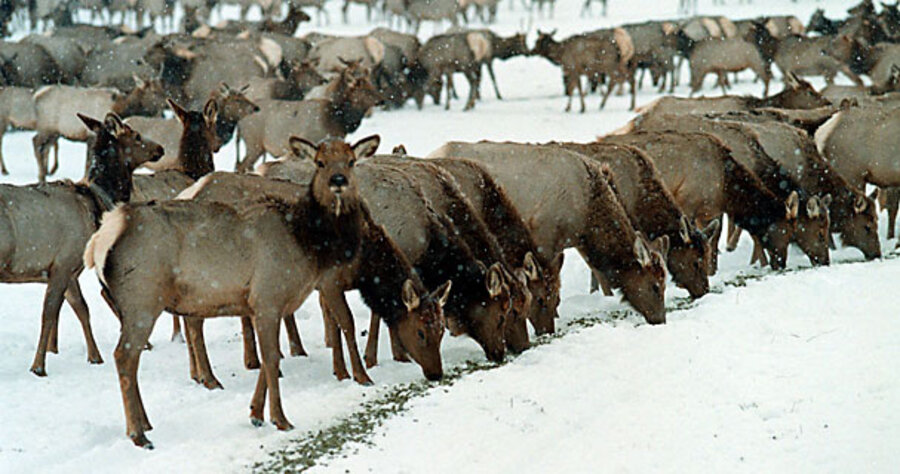Environmental groups want Wyoming elk to starve
Loading...
Five conservation groups have filed suit in a federal court to stop the US Department of the Interior from feeding elk in Wyoming's National Elk Refuge.
The groups say that the artificial feeding, which began a century ago, is creating a breeding ground for diseases that are harmful to wildlife and livestock.
The suit, was filed Tuesday by Earthjustice, a nonprofit environmental law firm, on behalf of the Greater Yellowstone Coalition, Jackson Hole Conservation Alliance, Defenders of Wildlife, Wyoming Outdoor Council, and the National Wildlife Refuge Association. An Earthjustice press release alleges that the feedings are destroying the ecosystem:
Winter feedings on the National Elk Refuge have altered the plant and animal communities so dramatically that it is no longer a healthy, properly functioning environment. This practice violates the National Wildlife Refuge System Improvement Act, a directive from Congress to provide healthy habitat. The agency's current plan acknowledges the potent disease risk that accompanies high concentrations of animals like those found on the Elk Refuge in winter, and that the best way to reduce the threat and promote healthy populations of bison and elk is to phase out the annual winter feeding. Yet the plan takes no action to address the threats to the refuge and the elk that live there.
"Elk feeding was established as a means to help the elk, but now we know that crowded feedlines threaten a wildlife disease epidemic that could kill hundreds of these magnificent animals," said Tim Preso of Earthjustice who is representing the coalition. "It's time to adapt our elk management to deal with this disease threat before elk start dying on the National Elk Refuge."
"Basically we've got way too many animals on too small an area for too long a time," said Barry Reiswig, a retired National Elk Refuge manager. "They're way over the Elk Refuge's carrying capacity."
The environmental groups contend that the feedings create an ideal environment for the transmission of chronic wasting disease, considered fatal to elk, moose, and deer, as well as brucellosis, a bacterial infection believed to cause spontaneous abortion in cattle.
On Tuesday, the Monitor reported that 4,700 bison have been slaughtered in the past six months in a controversial plan to prevent them from infecting beef cattle with brucellosis.
The Associated Press notes that the practice of feeding the elk began a century ago, when homesteaders sought to keep elk from starving after cattle herds had eaten much of the grass. Last winter, some 8,300 elk and 920 bison ate more than 8.4 million pounds of alfalfa pellets – the equivalent of 175 semitrailer loads of feed.
The New York Times says that there's a lot of money at stake in keeping the elk from starving:
Wyoming’s economy would be affected by ending the feeding of elk at the refuge, which has become a tourist attraction. Last winter more than 25,000 people paid $16 each to ride on sleighs pulled by horses among herds of elk on snow-covered landscapes. In addition, ranchers do not want hungry wild elk competing with their cattle for food, and hunting outfitters want assurances that plenty of animals will be available for their clients to stalk.
According to the AP story, hunting groups have been pressuring the Interior Department to continue the feedings:
Bob Wharff, executive director of Wyoming Sportsmen for Fish and Wildlife, said an abrupt end to feeding could have negative consequences.
"There comes a point where you don't feed them and they get to a weakened state. They'd get far more susceptible [to disease]," he said.
Wharff said a study done for his organization several years ago indicated elk populations would decline by 60 to 80 percent if feeding stopped.
"I don't think anybody is going to sit back and let them all starve to death," he added.
[via KSJ Tracker]
Update: Be sure to read the first comment from Sophie Osborn, a wildlife biologist for the Wyoming Outdoor Council, one of the plaintiffs in the suit. She correctly points out that the plaintiffs are not calling for a sudden halt to the feedings, but rather a five-year phase out.





